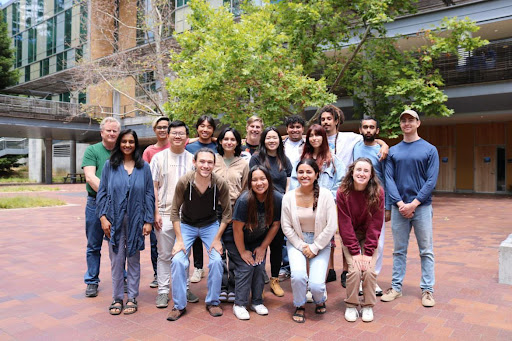Campus News
UCSC iGEM developing yeast-based type 2 diabetes medication for 2022 international competition
14 UCSC undergraduates are addressing access and cost of Type 2 diabetes medications by creating an alternative, yeast-based treatment that will be presented at the 2022 iGEM Jamboree in Paris.

With just three months remaining until the International Genetically Engineering Machine (iGEM) Jamboree in Paris, France, the 2022 UC Santa Cruz iGEM team is making steady progress on their project: an alternative treatment for Type 2 diabetes, a chronic condition that affects the body’s ability to regulate blood sugar and the 7th leading cause of death globally. Their project addresses the high costs and limited availability of diabetes medication with a yeast-based treatment, which would allow underserved populations around the world to grow and access the medicine locally.
Each year, a new team of UCSC undergraduates participating in iGEM chooses a synthetic biology project that aims to solve a pressing global health issue and joins hundreds of other teams from universities around the world in a global competition. The UCSC team is advised by David Bernick, associate teaching professor of biomolecular engineering (BME), and receiving additional support and mentorship from UCSC Ph.D. student and TA Eric Malekos and Hartnell College intern Gabino Guzman.
After forming in December 2021, the team’s first priority was to identify a project that was both viable and addressed a pressing global health challenge.
“We asked team members which project, out of four total, they thought would be the most feasible and would be able to make a substantial impact,” said Elizabeth Beer, BME student and one of this year’s captains. “At the end, we had consensus on moving forward with the diabetes treatment idea.”
When both diabetic and non-diabetic individuals eat, glucagon-like-peptide-1s (GLP1s) are naturally secreted in response to the rise in blood glucose levels. The secretion of GLP1s causes a cascade effect, which ultimately leads to the release of insulin to regulate blood sugar.
People living with Type 2 diabetes either lack insulin sensitivity or resist insulin. A class of medication currently used to treat Type 2 diabetes is called GLP1 RA, glucagon-like-peptide-1 receptor agonists. GLP1 RA medications mimic the binding that occurs between GLP1 and its receptor in the body and have longer half lives. This allows for GLP1 RAs to be an attractive and effective treatment for Type 2 diabetes.
“GLP1 RAs are really effective for people with Type 2 diabetes because their issue is insulin sensitivity, not necessarily insulin production,” said Kiana Imani, a BME student and team co-captain. “GLP1 RAs are at the forefront of Type 2 diabetes treatment, but are wildly expensive and not easily accessible in many parts of the world, with underserved populations most affected. Our team’s focus is to develop an inexpensive and naturally derived treatment to address the high cost and limited accessibility of diabetes medication.”
GLP1 RAs are naturally-derived peptides and can be produced naturally within a plant host, an organism that houses a smaller organism, such as soybeans, yeast, or microalgae—all organisms that the team has considered employing for their project because of their ability to grow fast and be manipulated at the genetic level.
“We’re trying to find a host or multiple hosts that allows us to prove our concept within the relatively short timeline of our project,” said Gia Balius, human biology student and UCSC iGEM team member.
This summer, team UCSC is working in the lab daily. Wet lab work will begin soon as they bring their project to the test phase. The team is divided into four focuses: host development, plasmid design, human impact, and wiki (documentation).
The host-finding group is researching organisms, like yeast or microalgae, to create a bio-encapsulated version of the medication. The plasmid design group will work on inserting the bioengineered gene into the host organism. Plasmids are small DNA structures in the cells of bacteria that have the ability to self-replicate.
The human impact group is connecting with diabetes patients, doctors, and other health professionals to learn more about how their approach can help those that are most impacted by the limited availability and high cost of diabetes medication. The wiki group is building the team’s website, where they will share weekly updates, lab notes, resources, and any other information about their project.
“Our team structure is completely horizontal; we’re all equal in the lab and have the freedom to experiment,” Imani explained. “We’re also given a lot of creative freedom from Profesor Bernick, which allows us to get a ton of hands-on experience and learn new concepts by doing.”
The past two UCSC iGEM teams won gold at the annual iGEM Jamboree. Team Progenie, which designed a system to target and eliminate a toxic gene found in Shiga toxin-producing E. coli—a family of bacteria responsible for some of the most severe forms of food poisoning—won in 2021. And the 2020 team earned gold for developing a cellulose-based biodegradable plastic for strawberry growers called Komaplastics that breaks down into glucose monomers that the microbes in soil can use as nutrients and allows farmers to till the plastic into the soil at the end of the growing season, keeping it out of landfills.
The 2022 iGEM competition will be held October 26–28 in Paris, France. This will be the first time in three years that team UCSC will be traveling to the competition. Stay tuned for updates on the team’s progress this summer and fall at engineering.ucsc.edu/news.